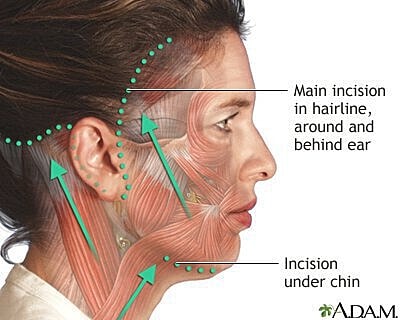placeholder













This technique provides comprehensive rejuvenation to the brow, upper and lower eyelids, cheek, lateral face, jawline, and neck. All patients also receive intraoperative volumization via structural fat grafting or with commercial dermal filler platform. Patients undergo intraoperative laser resurfacing for maximal results as well. While this technique provides our most transformative results, it also requires more recovery time than our limited incision technique. Like all of our facelift techniques, SMAS tightening is the engine of the face and brow result. This procedure offers a true harmony between all zones of the rejuvenated face, as it addresses each component of aging.
The Ocean Drive Full Facelift undertakes a very wide, comprehensive undermining of the skin and SMAS. This wider area of surgery leads to a greater degree of lift and skin removal, but it also causes swelling. While bruising is uncommon following this procedure, patients can expect swelling for 1-3 weeks following the procedure.
1 of 9
The seminal difference between this approach and the limited incision approach is that this specific procedure will tighten and elevate the lateral brow, and offer enhanced elevation to the malar fat pad (aka the cheek).
As with any other facial procedures, tension is placed on the deeper planes rather than the skin to allow for the best overall scar result. This specific procedure is commonly associated with upper and lower eyelid blepharoplasty, as combining periorbital rejuvenation with comprehensive facial rejuvenation produces a very natural, harmonious result that can last decades.


Recovery time for this procedure is 5-7 days longer than our limited incision facelift approach, as the hairline, lateral brow, and lateral periorbital area are rejuvenated in combination with the midface, lower face, and neck.
Incisions are extended into the superficial hairline above the ear, stopping at the lateral aspect of the lateral eyelid. Hair loss with this procedure has never been seen with this approach at our institution, but it is a theoretical risk. Drains are not required for this procedure. This is our second most common procedure in women, but is not as commonly requested by male patients.
The ideal patient for this procedure is a female who has heaviness to her brow, but has an overall good brow position. It is less invasive than a formal brow lift, but provides a significant elevation to the lateral brow. This procedure is also commonly combined with laser resurfacing for maximal improvement of skin quality.

A facial dressing will be applied before you leave the operating room; it is to remain in place until the following morning. You should be as quiet as possible during this time; therefore, a great deal of talking and having too many visitors are discouraged. If your dressing begins to feel excessively tight or uncomfortable, please let us know. The dressing can be removed the following day after surgery unless told differently by either Dr. Durkin or the nurse. During your initial post-op appointment you will be placed in a bandeau to be worn 21 days.
There is usually little actual pain following a facial reconstruction, but you may experience a deep bruised sensation as a result of the swelling, and the face may seem heavy, this can seem worse at night and when one becomes nervous. You will receive a prescribed pain medication and it can often cause sensations of light-headedness or sleepiness, particularly in the immediate post-operative period. If you choose to not take prescribed pain medication you may take Tylenol. Under no circumstances should ASPIRIN, IBUPROFEN, or medications containing aspirin or salicylates or ibuprofen, be taken without first consulting us. If the pain is severe and the prescribed pain medication is not helping please do not increase the recommended dosage or supplement with your own medications. Notify our office and we will evaluate the next step in controlling your pain.
Every operation, no matter how minor, is accompanied by swelling of the surrounding tissues. The amount varies from minimal to extensive. Sometimes the swelling becomes a little greater 48 hours after your operation and will gradually decrease. Swelling is generally worse when you first get up in the morning. The swelling itself is not serious and is not an indication that something is going wrong with your operation.
It may take several weeks for the swelling to diminish completely. After the swelling diminishes though, you may notice or feel some unevenness (lumpiness) under the skin; this will gradually disappear.
The main thing to remember is the swelling eventually subsides; you can help in several ways:
Soft washcloths or the ice packs that we provide to you can be used. Some patients have even used bags of frozen peas due to the fact that they will conform to the face. If you decide to use a soft cloth, dip in water with ice chips. They may be placed in a plastic wrapper such as a baggie to avoid wetting your clothing. Apply your preferred method across the jaws and neck for twenty minutes several times daily during the first 3 days may help reduce swelling, discomfort, and discoloration.
Discoloration and bruising are normal with a facial reconstruction. Like the swelling, it may become more pronounced especially in the neck and chest area after the first day or so, but remember this is temporary. You may apply Topical Arnica Cream to discolored areas avoiding incision sites.
Every post-op patient will receive the following four meds which may be adjusted due to medication allergies etc.
You may shower once you’re cleared by Dr. Durkin. When Dr. Durkin gives the ok you may shampoo your hair and gently cleanse the incisions with soap and water. Avoid “scrubbing” the incision sites. Use a gentle massage with your fingertips around the incisions. Have someone with you and a chair nearby the first couple of days that you shower. You may get a little dizzy and will need to sit down. Gently towel dry hair and allow to air dry. Do not use a hair dryer or curling iron until after the staples and sutures are removed. Your scalp could have some numbness for up to a few months after surgery so it is important that you use extreme caution when using a blow dryer or curling iron until the numbness is gone. Keep incision site clean using dial soap and applying bacitracin to incision site.
An antibiotic has been given to you. This is begun the day after surgery and continued until gone. Avoid extreme turning of the head as this may place undue tension on the healing suture lines, but on the other hand, do not hold head rigid as this will result in stiffness of your neck. Under no circumstances should ASPIRIN, IBUPROFEN, or medications containing aspirin or salicylates or ibuprofen, be taken without first consulting us.
The night of your surgery you may feel nauseated. We have provided you with anti-nausea medication. You can take the medication and only take a few ounces of clear fluids until the nausea passes. There are no restrictions to what you can and can’t eat. Let your body determine what you feel like eating. Please no drinking of alcohol for the first 3 weeks and/or while taking the pain medication and the anti-anxiety medication. Alcohol may raise the blood pressure and initiate bleeding.
It is not unusual for an individual to go through a period of mild depression after cosmetic surgery because, no matter how much they wanted the operation beforehand and how much they were told about what to expect post-operatively, they are shocked when they see their face swollen and, perhaps, discolored. Be realistic and realize that this is a very temporary condition which will subside shortly. The best “treatment” consists of busying one’s self with the details of post-operative care and trying to divert one’s attention to other thoughts. Do not compare your progress with that of other patient’s, everyone heals differently.
Limit your activity over the first week following your surgery. We encourage walking, but AVOIDING bending over at the waist, or picking up heavy objects, or straining in any way. If you overexert yourself, bleeding may result. You may slowly resume your activities after the first week, but please avoid any strenuous activity until Dr. Durkin gives you the OK…this is usually around 3 weeks after surgery.
If the activity involves being outside please use the appropriate protection from the sun (sunscreen, hat, etc.), even a mild sunburn may cause prolonged swelling and/or irritation of the incisions and skin.
Returning to Work and resuming Social Activities
When you should return to work depends on the amount of physical activity and public contact your job involves and also the amount of swelling and discoloration you develop; the average patient may return to work or go out socially 2-3 weeks after surgery when these factors are minimal- you will have to play this by ear! Do not drive for 2 weeks and/or if you’re taking the pain medication.

Our expert team offers non-surgical face treatments that can help you achieve a more youthful and refreshed appearance without the need for surgery. Our state-of-the-art techniques and technologies are designed to lift and tighten the skin, giving you a more youthful and radiant look.
Plus, with our minimally-invasive approach, you can enjoy quick and easy recovery with no down time. Explore our website to learn more about our non-surgical face treatments and schedule a consultation today to take the first step towards a more youthful you.